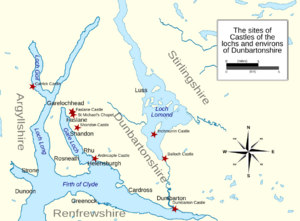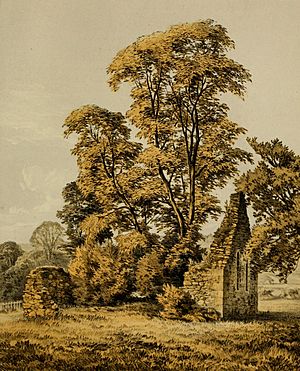Faslane Castle, Shandon Castle, and St Michael's Chapel facts for kids
Faslane Castle and Shandon Castle were two old Scottish castles. They once stood near the shores of the Gareloch in Argyll and Bute, Scotland. This area is between the village of Garelochhead and the town of Helensburgh. People in the 1800s believed these castles were built a long time ago, during the Middle Ages. Back then, this land was part of a region called the Lennox, ruled by powerful leaders known as mormaers.
Today, there's nothing left of Faslane Castle. However, in the 1800s, some ruins of Shandon Castle were still visible. Close to where Faslane Castle once stood, you can find the remains of St Michael's Chapel. This chapel is also thought to be from the Middle Ages.
Contents
Faslane Castle: A Look Back
Faslane Castle (grid reference NS24949016) was a castle that used to be near Faslane in Argyll and Bute. It was also part of the old county of Dunbartonshire. The castle site is about 1.7 miles (2.7 km) north of the modern town of Shandon. It's also about 1 mile (1.6 km) south of Garelochhead. The site looks out over the Gareloch. Today, it's mostly covered by Her Majesty's Naval Base Clyde, a large naval base.
Who Owned Faslane Castle?
During the Middle Ages, the lands of Dunbartonshire were part of a larger area called the Lennox. This region was controlled by the mormaers of Lennox. In the early 1200s, a mormaer named Ailín II gave a large piece of land on the east side of the Gare Loch to his younger son, Amhlaíbh.
Later, a person named Walter of Faslane came from Amhlaíbh's family. Walter was the great-grandson of Ailín II. When Mormaer Domhnall passed away, Walter became the main male heir of the Lennox family. He married Margaret, who was Domhnall's daughter. This marriage made Walter a mormaer in his own right.
When Was Faslane Castle Built?
According to a historian from the 1800s, William Fraser, Faslane Castle was believed to have been built in the 1100s. A modern expert on the Middle Ages, Geoffrey Stell, studied old castle mounds in Scotland. He found only four in Dunbartonshire, and Faslane was one of them. Fraser also said that the castle was often used by the earls of Lennox or their family members.
|
Than to Faslan the worthy Scottis can pass, |
| — Blind Harry, The Wallace |
Faslane Castle even appears in a famous poem from the 1400s called The Wallace. This poem was written by a poet known as Blind Harry. The story in the poem says that William Wallace attacked the town of Dumbarton and destroyed Rosneath Castle. Rosneath is on the other side of the Gare Loch from Faslane. After that, Wallace crossed the loch to Faslane Castle. There, he was welcomed by Mormaer Maol Choluim I.
What Happened to Faslane Castle?
Over the years, Faslane Castle changed hands many times. In 1543, Matthew Stewart, Earl of Lennox gave Faslane to Adam Colquhoun. Later, in 1567, it was bought by Campbell of Ardkinlass, who then sold it to Campbell of Carrick before 1583. By 1693, Sir John Colquhoun of Luss owned it. He then leased it to Archibald MacAulay of Ardincaple.
A historian named Joseph Irving wrote in the 1800s that in the mid-1700s, the ruined Faslane Castle gave shelter to the last leader of the MacAulays of Ardincaple. This family was once very powerful.
By 1869, historian Fraser said that no buildings or parts of the castle could be seen anymore. He mentioned that the only sign left was a green mound. This mound overlooked where two deep valleys met, between two small streams with steep banks. Another writer, William Charles Maughan, also said that the castle site could be recognized by a small mound near a "murmuring burn" (a small stream) that flowed into the bay.
Maughan also wrote about an oak tree at Faslane. This place was called Cnoch-na-Cullah in Scottish Gaelic, which means "knoll of the cock." Legend says that when a rooster crowed under the branches of this old oak tree, a member of Clan MacAulay was about to die.
It is believed that the site of Faslane Castle was completely destroyed when the West Highland Railway was built over it between 1891 and 1894.
St Michael's Chapel: An Ancient Ruin
56°4′10″N 4°48′53″W / 56.06944°N 4.81472°W
Near where Faslane Castle once stood, you can find St Michael's Chapel (grid reference NS2489589862). In 1869, Fraser described the chapel's ruins as measuring 43 by 23 feet (13.1 by 7.0 meters). He noted that many stones had been taken from the site. Only two gable ends (the triangular parts of a wall at the end of a pitched roof) were still standing when he wrote about it. He also mentioned that the foundations of what was thought to be the priest's house could still be seen between the chapel and a barn. Near a stream below the bank, he found a spring called "The Priest's Well."
Historians George Chalmers and architects David MacGibbon and Thomas Ross believed the chapel was dedicated to St Michael. They thought it might have been built in the 1200s or 1300s. In 1963, the Ordnance Survey visited the site. They noted that the chapel and its south wall had been rebuilt without mortar to a height of 1.3 meters (4.3 feet). However, there were no signs of the original burial ground, the priest's house, or the well. Today, the site is part of a modern cemetery.
The St Michaels Roman Catholic Church in Dumbarton mentions that it was a tradition to dedicate churches to St Michael in this area. For example, in Glen Luss, there are remains of an old church dedicated to the saint from before the Scottish Reformation. In Helensburgh, there is an Episcopalian church named 'Saint Michael and the Angels'. Also, in the Middle Ages, there was a chapel dedicated to St Michael in the Strathleven area of Dumbarton.
Shandon Castle: A Lost Landmark
56°3′6″N 4°47′59″W / 56.05167°N 4.79972°W Shandon Castle (grid reference NS257878) was another castle that once stood near the small village of Shandon. This village is located between the site of Faslane Castle and the town of Helensburgh, both on the shores of the Gare Loch. Fraser described the site of Shandon Castle as being on a hillside, above the house of Shandon. He stated that parts of the castle still existed when he was writing. The site was known as "the old Dun" (an old fort). According to Fraser, there were no stories or traditions about the castle left at that time.
See also
- Clan MacAulay, a Scottish family that once lived near these castle sites.
- Mormaer of Lennox, the ancient rulers of the Lennox region.
Images for kids




